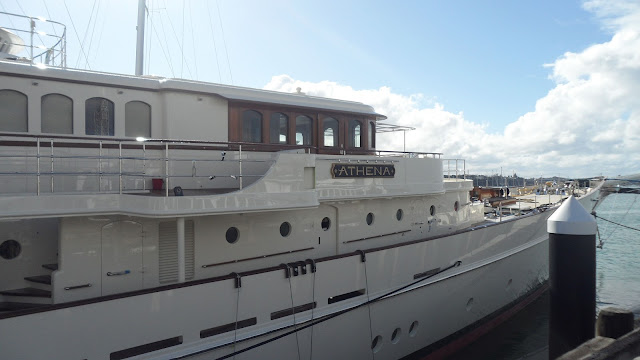Yacht and ship has completely different construction process and methods mainly because of the size they have and the materials of them being used (wood, etc.). They presumably both start from conceptual design even this step is slightly different from each other.
Conceptual design
Set up a goal and plans of shipyards by demand prediction
Procure design ability for winning a contract (obtain order)
Ship performance evaluation, construction planning, ship cost agreement
Set up ship specification and concept for contract
Order material and make construction white paper
Design
Basic design: draw basic drawing (midship section, construction profile, shell expansion, etc) for approval, send to the owner/classifications
Detail design: draw various outfit drawing order steel material for construction
Construction design: draw shop drawing (concept such as out sourcing for construction efficiency
Construction
Preprocessing/manufacturing: manufacture materials into small for blocks (only for shipbuilding), automatic process maximization by marking, bending, cutting
Assembly: assemble blocks, units, apply specialized process each line
Erection: move blocks, block by block erection, increase dock turnover rate by pre-erection process maximization
Pre-outfitting/painting: docks (mainly for shipbuilding) and quay turnover rate maximization by pre-outfitting/painting
Sea trial/delivery
Check weather various parts of ship are right or wrong
Non-official sea trial (self-inspection by shipbuilder), official trial (under classification, owner, correspondence observing)
Preprocessing sequence
Steel material treatment: store and pile up steel material from steel mills
Surface handling: treatment iron oxide or moisture, oil made during material treatment for later process (shot blasting, sand blasting, etc.)
Strain rectifying: a step for strain or damage (roller, press)
Painting: light painting for avoiding oxide iron (shop primer, usually by zinc)
Quality management transition
Worker QM
Manager QM
Inspection QM: hiring specialized inspector
Statistical QM: statistical QM by sampling through construction process
Comprehensive QM: overall life-cycle
Workshop arrangement and facilities
Principle of workshop arrangement
Facilitation of material flow
Consideration about henceforward ship types
Construction efficiency increasing by site condition(weather, labor, etc.)
Consideration of surface plate area decision
Shipyard site condition
Annual construction amount and construction period
Ship type
Manufacturing ability
Outdoor, indoor manufacturing work rate
Surface plate turnover rate
Facilities
Generic term of concrete fixed assets
Requirements for reasonable facilities
Available working safely and sanitarily
Able to guarantee quality
Valid ability as one of the construction systems
Construction management system
Design to be the most economical thing and improve, construction rate increase and cost reduction technique
-> labour, material, facilities and work methods are combined in an interact way, which is physical and conceptual combination for making profit of a goal of company by 1.producing the product good quality 2.in due date 3.economically
Construction management technique
Planning function: long, mid term and short term practical plan
Practical function
Control function: depends on manager’s ability (adjustment between certain steps being out of orbit or delayed or crashed)
Analysis function
QM function (evaluation, inspection)
Function of classifications
Investigation for the risk related to flow of certain ships, prove safety of ship
Establish rules and regulations for design, construction and maintenance of ship
Ship insurance mediation, decision simplification, making document working for safety laws of the government easy
3 technological innovation of shipbuilding
Welding(from rivet): by wartime standard ship and the 2nd world war
Block assembly: big size ship
Automation
Schedule planning system(top-down)
Set up the schedule by given data about the production unit treated at certain step(visualized in a way of network or bar-chart)
Schedule management system(bottom-up)
Adjustment (ex: overtime, etc.)
Main function of construction management system
Demand prediction – analyze and decide data and reference, establish a long-term policy
Long/mid-term planning – basic schedule of shipyards
Production schedule planning – detail schedule for each ship
QM – production and guarantee
Stock control –
Ship material – order available after contracts (let them stock at proper point so storage period minimization
Common material – stock available
Facility maintenance – set up maintenance interval for each facility considering property
Cost and human resource



































